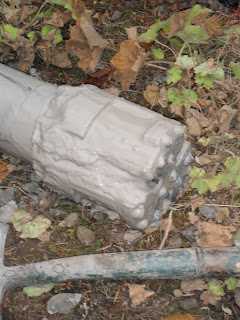But, what happened next was that as the drillers were feeding the pipe in, at about 90 metres, they hit an obstruction. They started pulling the pipe back out again with the intention of re-boring the hole with the drill but when they started pulling the pipe out it caught on another obstruction. They tried everything to get the pipe back out again including tying it to the drilling rig and pulling it out that way but eventually it just snapped. I assumed that they might be able to clear out the pipe with the drill but apparently the plastic is so robust that the drill would just have bounced off it.
 |
| Feeding the pipe down the hole |
 |
| trying to pull the pipe out again with the rig |
The only option was to drill hole number four. We had a long debate about where to put this and eventually agreed that putting it on the lawn was the best option. Or maybe the least worst option.
Thankfully the fourth hole went very quickly and smoothly (although it also required a significant amount of casing - in this case around 35 metres) and they were finished it in a day and half.
We were pretty nervous about having the rig on the lawn not so much because of the mess it would make while drilling but because it might churn up they lawn while they were driving it on and off, and also having to have trenching across the middle of the lawn.
 |
| Moving the rig off the lawn once the drilling was finished |
Knowing how nervous (precious?) were were about the lawn, the guys were very careful when driving the rig off. The mess left at the hole and over the lawn was absolutely minimal.
So, the drilling that was supposed to take four to five days has actually taken two weeks which was a bit of a pain but no more than that. We felt sorrier for the drillers who were completely gutted by what happened with the third hole, given they were so close to getting it completed.
It's also worth mentioning that the guys operating the rig were really good to get on with and very focussed on getting the job done. They also didn't mind us prancing around taking photos of them all the time and asking daft questions about what different bits of kit did.
I'm expecting we'll now have a short hiatus while we sort out getting a 3-phase meter put on the house. We already have a 3-phase supply so it should be a straightforward operation but requires Scottish and Southern to come out and do it so we're not holding our breath. Once that's done, we can get the trenching and groundwork done to get the pipes into the house, and then get the heat pump itself installed.
In the mean time, the in-laws and lack of oil are getting closer and closer. There's a sense of inevitability about the two coinciding.




































